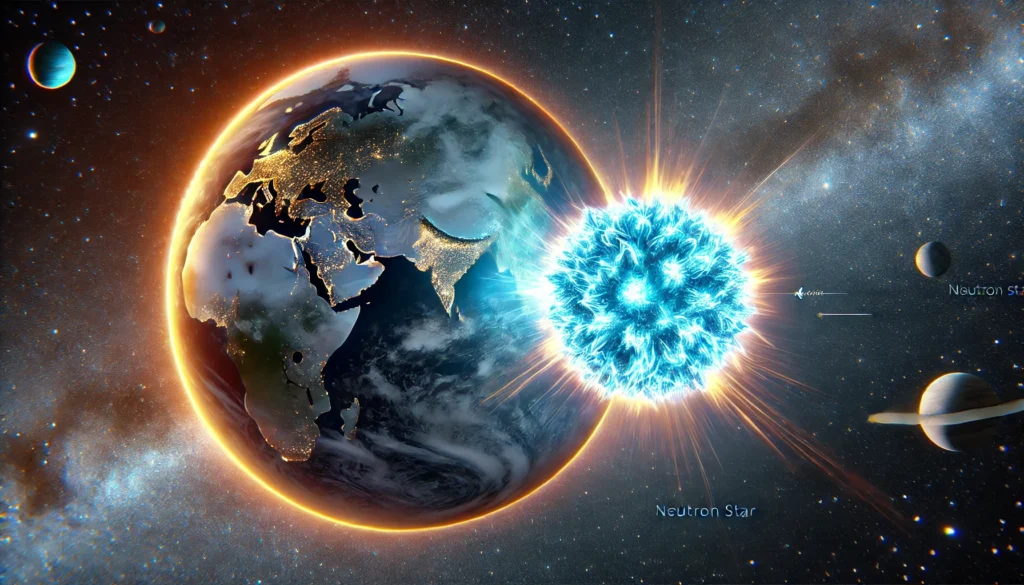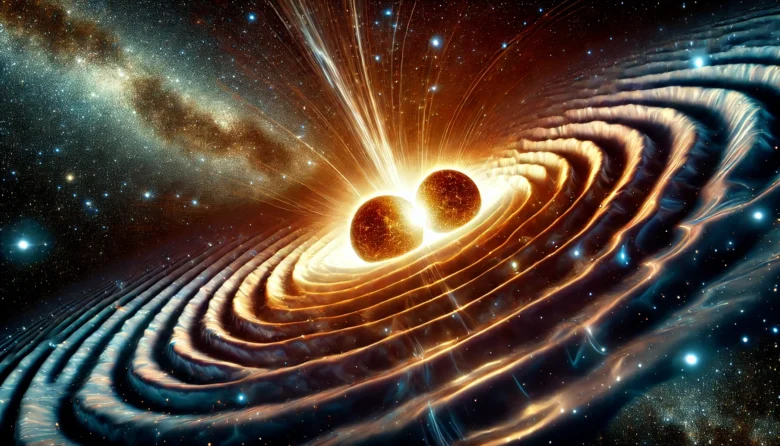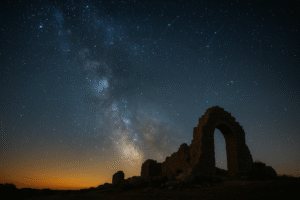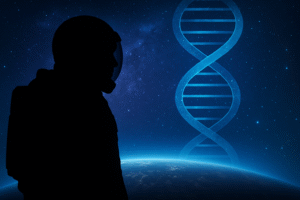Fun Fact: Did you know that the merger of two neutron stars can cause ripples in space-time itself? These ripples are known as gravitational waves!
In recent years, gravitational waves have taken centre stage in the realm of astrophysics. These faint ripples in space-time, predicted by Albert Einstein over a century ago, were first detected in 2015, and they have opened an exciting new window into the universe. But what exactly produces these waves? One of the key players in this cosmic orchestra is the neutron star—a stellar remnant so dense that just a teaspoon of its material weighs about a billion tons! In this blog, we’ll explore the fascinating role of neutron stars in helping us understand gravitational waves and why this discovery is so crucial to modern science.
What Are Neutron Stars?
When a massive star exhausts its fuel, it explodes in a supernova, leaving behind a core. If this core isn’t heavy enough to form a black hole, it becomes a neutron star. Neutron stars are incredibly dense and small, about 20 kilometres (12 miles) in diameter, but containing more mass than the Sun. Imagine squeezing a star into a city—this is the kind of extreme physics we’re dealing with.
Neutron stars emit electromagnetic radiation and can spin at incredibly high speeds, sometimes hundreds of times per second. These spinning neutron stars are called pulsars because they appear to pulse light in regular intervals. But while pulsars are awe-inspiring, what truly fascinates scientists is what happens when two neutron stars collide. It’s these collisions that create some of the most dramatic gravitational waves we’ve ever observed.
The Discovery of Gravitational Waves
Gravitational waves were first detected in 2015 by the Laser Interferometer Gravitational-Wave Observatory (LIGO), located in the United States. LIGO is a collaborative project led by several universities and research institutions to detect these space-time ripples. Shortly after this, in 2017, a breakthrough event occurred: the detection of gravitational waves from the collision of two neutron stars. This event, known as GW170817, was a major milestone and confirmed that neutron star mergers are a key source of gravitational waves.

In simpler terms, when neutron stars merge, the collision is so intense that it literally distorts the fabric of space and time, creating waves that travel outward at the speed of light. These waves are so faint by the time they reach Earth that they can only be detected by ultra-sensitive instruments like LIGO and its European counterpart, Virgo.
Why Are Neutron Star Mergers Important?
So, why do scientists care so much about neutron stars and their collisions? For one, these mergers allow us to study extreme conditions that can’t be replicated on Earth. The gravitational waves emitted by these collisions carry information about the neutron stars’ mass, spin, and even the mysterious material that makes up their cores. By studying these waves, researchers can better understand the physics of dense matter and test Einstein’s general theory of relativity in extreme environments.
Neutron star mergers are also important for another reason: they produce heavy elements like gold and platinum. In fact, much of the gold on Earth may have been created during ancient neutron star mergers! This discovery adds a new dimension to our understanding of where the universe’s elements come from.
The Role of Gravitational Waves in Modern Astronomy
Before gravitational waves were detected, much of what we knew about the universe came from observing light. Whether it was visible light, radio waves, or X-rays, astronomers had to rely on electromagnetic radiation to study celestial objects. Gravitational waves, however, don’t interact with matter in the same way as light, which means they can pass through regions of space that light cannot. This gives scientists an entirely new tool for exploring the universe.
Gravitational waves can help us probe phenomena that were previously invisible, like black hole mergers and neutron star collisions. In fact, the 2017 detection of a neutron star merger was followed up by observations from telescopes around the world, allowing astronomers to study the event in multiple wavelengths of light. This combination of gravitational wave data and traditional light-based astronomy is what researchers now call “multi-messenger astronomy.” It provides a more complete picture of these extraordinary cosmic events.
Real-World Applications and Future Research
The detection of gravitational waves is more than just a scientific curiosity. It has the potential to revolutionize our understanding of the universe and the laws of physics. For instance, studying gravitational waves could help us determine the rate of the universe’s expansion more accurately, contributing to research on dark energy and the ultimate fate of the cosmos.
Additionally, these discoveries have potential real-world applications. Advances in the technology used to detect gravitational waves, such as the lasers and mirrors in LIGO, could lead to innovations in fields like precision measurement and quantum computing. Companies like IBM, known for their work in quantum computing, could benefit from this leap in technology, potentially influencing industries ranging from cybersecurity to pharmaceuticals.
The future of gravitational wave research looks bright. In the coming years, more advanced detectors will come online, capable of detecting weaker waves from more distant sources. This will allow scientists to study even more neutron star mergers, black hole collisions, and other exotic phenomena. The European Space Agency (ESA) is also planning to launch a space-based gravitational wave observatory known as LISA (Laser Interferometer Space Antenna), which will be even more sensitive than Earth-based detectors.
Conclusion
Neutron stars are not only fascinating in their own right but play a crucial role in our understanding of gravitational waves. The detection of gravitational waves from neutron star mergers has opened up a new era in astronomy, allowing us to study the universe in ways that were previously unimaginable. These cosmic collisions offer insights into the fundamental laws of physics and provide a window into some of the most extreme environments in the universe.
As we continue to explore this new frontier, the potential for discovery is limitless. From better understanding the origins of heavy elements like gold to unlocking the mysteries of dark energy, neutron stars and gravitational waves will continue to captivate scientists and the public alike. The next time you look at a piece of gold jewellery, remember—it might have been forged in the fiery collision of two neutron stars billions of years ago!
Author’s Note
Exploring neutron stars and gravitational waves reveals that the universe is brimming with unexpected discoveries waiting to be uncovered. I hope this blog has sparked your curiosity and inspired you to learn more about the cosmos!
G.C., Ecosociosphere contributor.
References and Further Reading
- LIGO’s Official Website
- Gravitational Waves Explained by NASA
- Phys.org | Archive : 03/05/2013. https://phys.org/archive/3-05-2013/
- Neutron Free Essays | Studymode. https://www.studymode.com/subjects/neutron-page1.html
- Clifton, T. (2017). 4. Gravitational waves. Oxford University Press EBooks. https://doi.org/10.1093/actrade/9780198729143.003.0004
- Multiple Microsecond-Length Fast Radio Bursts Discovered by Astronomers Using Green Bank Telescope – News Releases NSW Northern Rivers. https://www.heartlandmagazine.com.au/multiple-microsecond-length-fast-radio-bursts-discovered-by-astronomers-using-green-bank-telescope/
- FAST RADIO BURSTS (FRBs). https://upscexamnotes.com/upsc-article.php?article=fast-radio-bursts-(frbs)




